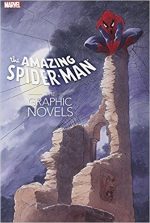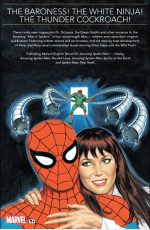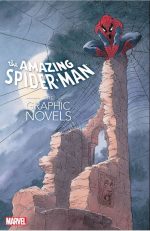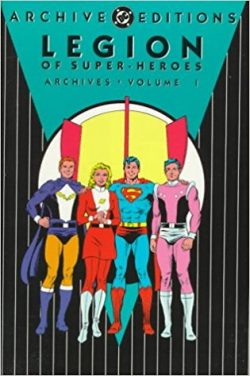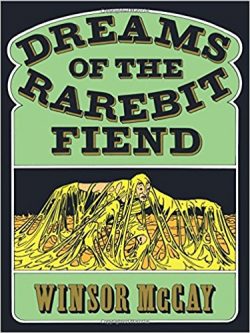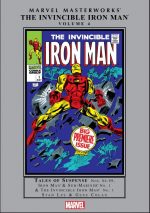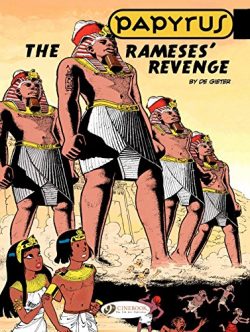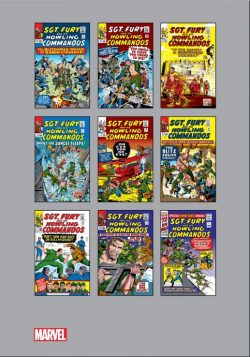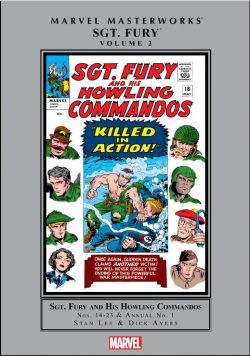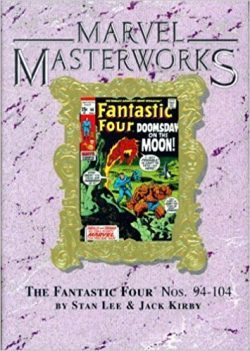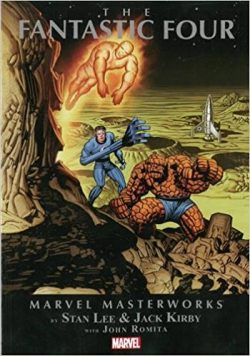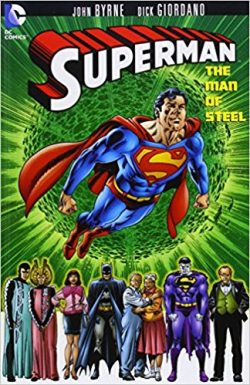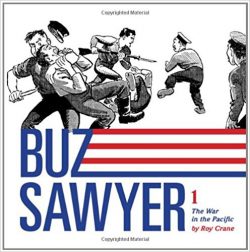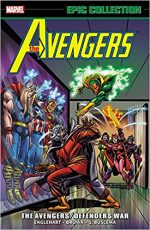
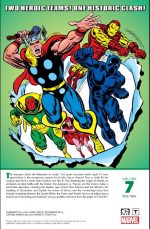
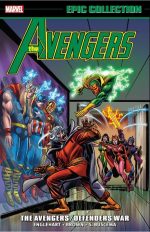
By Steve Englehart, Roy Thomas, Jim Starlin, Gerry Conway, Bob Brown, Sal Buscema, John Buscema, Rich Buckler & various (Marvel)
ISBN: 978-1-3029-1000-6
One of the most momentous events in comics history came in the middle of 1963 when a disparate gang of heroic individuals banded together to combat an apparently out of control Incredible Hulk.
The Avengers combined most of the company’s fledgling superhero line in one bright, shiny and highly commercial package. Over the intervening decades the roster has unceasingly changed, and now almost every character in the Marvel multiverse has at some time numbered amongst their colourful ranks…
The Avengers always proved that putting all one’s star eggs in on single basket can pay off big-time. Even when all Marvel Royalty such as Thor, Captain America and Iron Man are absent, it merely allows the team’s lesser lights to shine more brightly.
Of course, the founding stars always regularly feature due to a rotating, open door policy ensuring most issues include somebody’s fave-rave.
After instigators Stan Lee & Jack Kirby moved on, the team prospered under the guidance of Roy Thomas who grew into one of the industry’s most impressive writers, guiding the World’s Mightiest Heroes through a range of adventures ranging from sublimely poetic to staggeringly epic. He then handed over the scripting to a young writer who carried the team to even greater heights…
This stunning seventh trade paperback compilation – also available in eBook iterations – assembles Avengers #115-128 and Giant Size Avengers #1, plus crucial crossover episodes from Defenders #8-1, Captain Marvel #33 and Fantastic Four # 150; collectively covering September 1973 to October 1974 and celebrating an era of cosmic catastrophe and cataclysmically captivating creative cross-pollination…
For kids – of any and all ages – there is a simply primal fascination with brute strength and feeling dangerous, which surely goes some way towards explaining the perennial interest in angry tough guys who break stuff as best exemplified by Prince Namor, the Sub-Mariner and the Incredible Hulk.
When you add the mystery and magic of Doctor Strange the recipe for thrills, spills and chills becomes simply irresistible…
Last of the big star-name conglomerate super-groups, the Defenders would eventually number amongst its membership almost every hero – and some few villains – in the Marvel Universe.
No surprise there then since the initial line was composed of the company’s major league bad-boys: misunderstood, outcast and often actually dangerous to know. For Marvel in the 1970s, the outsider super-group must have seemed a conceptual inevitability – once they’d finally published it.
Apart from Spider-Man and Daredevil, all their heroes regularly teamed up in various mob-handed assemblages, and in the wake of the Defenders’ success even more super-teams featuring pre-existing characters would be packaged: The Champions, Invaders, New Warriors, Inhumans, Guardians of the Galaxy and so on… but never again with so many Very Big Guns…
The genesis of the team in fact derived from their status as publicly distrusted “villainsâ€, and they never achieved the “in-continuity†fame or acceptance of other teams, but that simply seemed to leave the creators open to taking a few chances and playing the occasional narrative wild card.
In 1973 wunderkind scripter Steve Englehart was writing both Avengers and Defenders (as well as Doctor Strange, the Hulk and Luke Cage, Hero for Hire) and, yearning for the days of DC’s summer blockbuster annual events, decided to attempt his own massive multi-player epic.
Bravely given the editorial go-ahead at a time when deadline crunches regularly interrupted ongoing storylines, the author and his regular pencillers Sal Buscema and Bob Brown laid their plans…
Threads had been planted as early as Defenders #4 with Englehart carefully putting players in place for a hugely ambitious cross-over experiment: one that would turn the comics industry on its head.
After earthly madwoman Barbara Norris was cursed by amoral Asgardian Amora the Enchantress, the human was transformed into an incarnation of old Avengers enemy Valkyrie. The denouement of the tale also left part-time Avenger and Defender the Black Knight an ensorcelled, immobile stone statue. As Strange and Co. searched for a cure, aided by the Silver Surfer and tempestuous Hawkeye (another ex-Assembler looking to forge a solo career), they all fell into a subtle scheme orchestrated by two of the greatest forces of evil in all creation….
This bombastic tome commences with Avengers #115 as lead story ‘Below Us the Battle!’ (illustrated by Bob Brown & Mike Esposito sees the critically- understaffed Avengers travel to England and the castle of the Black Knight, only to find mystic resistance, a troglodytic race of scavengers and their old comrade long missing…
The issue also contained a little prologue, ‘Alliance Most Foul!’, which revealed other-dimensional Dark Lord Dormammu and Asgardian god of Evil Loki united to secure an ultimate weapon which would give them ultimate victory against all their foes.
This despotic duo would deceive the Defenders into securing the six component parts by “revealing†that the reconstructed Evil Eye could de-petrify and restore the Black Knight – a plan that began with a similar prologue at the end of Defenders #8…
‘Deception’ (Englehart, Sal Buscema & Esposito) was the first chapter in ‘The Avengers/Defenders Clash’ disclosing that a mystic SOS message from the spirit of the Black Knight is intercepted by the twin gods of evil, leading directly to ‘Betrayal!’ in Avengers #116, wherein the heroes, hunting for their missing comrade, “discover†that their oldest enemies Hulk and Sub-Mariner may have turned the Black Knight to stone…
This and third chapter ‘Silver Surfer Vs. the Vision and the Scarlet Witch’ see the rival teams split up: one to gather the scattered sections of the Eye and the other to stop them at all costs…
Defenders #9 (with Sal Buscema & Frank McLaughlin art) begins with tense recap ‘Divide …and Conquer’ before ‘The Invincible Iron Man Vs. Hawkeye the Archer’ and ‘Dr. Strange Vs. the Black Panther and Mantis’ sheds more suspicion and doubt on the vile villains’ subtle master-plan…
In Avengers #117, ‘Holocaust’, ‘Swordsman Vs. the Valkyrie’ and crucial turning point ‘Captain America Vs. Sub-Mariner’ (all by Brown & Esposito) lead to the penultimate duel in Defenders #10 (Sal Buscema & Frank Bolle) in ‘Breakthrough! The Incredible Hulk Vs. Thor’ and the inevitable joining together of the warring camps in ‘United We Stand!’. Tragically, understanding comes too late as Dormammu seizes the reconstructed Evil Eye and uses its power to merge his monstrous realm with Earth.
Avengers #118 delivers the cathartic climactic conclusion in ‘To the Death’ (Brown, Esposito & Frank Giacoia) wherein all the heroes of the Marvel Universe resist the demonic invasion on hideously mutated home soil whilst the Avengers and Defenders plunge deep into the Dark Dimension itself to end forever the threat of the evil gods (well, for the moment, at least…).
With the overwhelming cosmic threat over the victorious Defenders attempt to use the Eye to cure their petrified comrade, only to discover that his spirit has found a new home in the 12th century.
In #11’s ‘A Dark and Stormy Knight’ (Sal B with Bolle inks), the group battle black magic during the Crusades, fail to retrieve the Knight and acrimoniously go their separate ways – as did overworked departing scripter Englehart, who dropped the “non-team†to concentrate on “The World’s Greatest Super-Heroesâ€â€¦
The drama resumes with a delightfully traditional spooky Halloween tale as the Avengers, warned by clairvoyant vision from martial arts enigma Mantis, head to Rutland, Vermont for the ‘Night of the Collector’ (#119, illustrated by Brown & Don Heck); encountering old friends, a dastardly and determined foe, blistering action and staggering suspense…
In ‘Death-Stars of the Zodiac!’ (Avengers#120, by Englehart, Brown & Heck), terrorist astrological adversaries and super-criminal cartel Zodiac attack again with a manic plan to eradicate everyone in Manhattan born under the sign of Gemini.
Thor, Iron Man, Vision, Scarlet Witch, Swordsman and Mantis are seemingly helpless to stop them but the blockbusting battle in #121’s ‘Houses Divided Cannot Stand!’ (illustrated by John Buscema & Heck,) and even the added assistance of Captain America and the Black Panther is of little advantage…
With Mantis injured the team begin to question her mysterious past, only to be lured to their seeming doom and ‘Trapped in Outer Space!’ (Brown & Mike Esposito) before at last turning the tables on their fearsome foes after the criminal Libra reveals a shocking secret…
Avengers #123, ( Brown & Heck) begins a vast and ambitious saga with ‘Vengeance in Viet Nam – or – An Origin For Mantis!’ as Libra’s claim to be Mantis’ father (a story vigorously and violently denied by the Martial Arts Mistress) sends the team to Indo-China in a big hurry.
The former mercenary declared that he left the baby Mantis with pacifistic Priests of Pama after running afoul of a local crime-lord, but the bewildered warrior-woman has no memory of such events, nor of being schooled in combat techniques by the Priests. Meanwhile, the gravely wounded Swordsman has also rushed to Saigon to confront his sadistic ex-boss Monsieur Khruul and save the Priests from being murdered by the gangster’s thugs… but is again too late. It is the same old story of his pathetic, wasted life…
Issue #124 has the team stumbling upon a scene of slaughter as dead clerics and criminals lead to a monstrous planet-rending alien horror freshly awakened in ‘Beware the Star-Stalker!’ (limned by John Buscema & Dave Cockrum)…
Mantis is forced to accept that her own memories are not real after Avengers #125, which unleashed ‘The Power of Babel!’ after a vast alien armada attacks and, in combating it, the Earth’s Mightiest Heroes are trapped out of phase with their home-world.
This blockbuster battle bonanza was a crossover, and the penultimate episode of the spectacular Thanos War Saga that had featured in Captain Marvel, Marvel Feature and Iron Man.
Included in this compendium is climactic last chapter of that epic, plotted and illustrated by Jim Starlin, scripted by Englehart and inked by Klaus Janson. ‘The God Himself!’ (from Captain Marvel #33) sees mad Titan Thanos finally fall in combat to the valiant Kree warrior: a stunning piece of comics storytelling which stands up remarkably well here despite being seen without benefit of the preceding ten chapters…
It’s back to Avengers business as Roy Thomas, Rich Buckler & Dan Adkins return to the fold to delve and reboot some superhero history with ‘Nuklo… The Invader that Time Forgot!’ for the first quarterly edition of Giant-Size Avengers.
The stirring saga reintroduced 1940 Marvel sensation Bob Frank AKA The Whizzer in a taut and tragic tale of desperation as the aged speedster begs the heroes’ help in rescuing his son: a radioactive mutant locked in stasis by the US Government since the early 1950s. Unfortunately, within the recently unearthed chrono-capsule, the lad has grown into a terrifying atomic horror…
Moreover, while in the throes of a stress-induced heart attack the Whizzer lets slip that he is the also the father of mutant Avengers Scarlet Witch and Quicksilver…
Back in regular continuity, Avengers #126 offers ‘All the Sights and Sounds of Death!’ (Englehart, Brown & Cockrum) as villains Klaw and Solarr invade Avengers Mansion in a devious attempt to achieve vengeance for past indignities, after which in #127 Sal Buscema & Joe Staton sign on as regular art team with ‘Bride and Doom!’ as the team voyage to the hidden Himalayan homeland of The Inhumans to attend the marriage of the aforementioned Quicksilver to elemental enchantress Crystal. Sadly, the happy event craftily coincides with an uprising of the genetic slave-race known as Alpha Primitives. Once again robotic giant Omega has incited the revolt, but this time it is controlled by an old Avengers enemy who reveals himself in the concluding chapter of the crossover…
The story wraps up in Fantastic Four #150 with ‘Ultron-7: He’ll Rule the World!’ by Gerry Conway, Buckler & Joe Sinnott, in which a devastating battle between FF, Inhumans and Avengers is ended by a veritable Deus ex Machina moment, after which, at long last ‘The Wedding of Crystal and Quicksilver’ ends events on a happy note.
But not for long as a final tale from Avengers #128′ sees the FF’s nanny Agatha Harkness get a new job tutoring Wanda Frank in actual sorcery to augment her mutant power. In Bewitched, Bothered, and Dead!’ (Englehart, Sal Buscema & Staton), the new student unwittingly allows dark mage Necrodamus access to the Mansion and the souls of the occupants, even as increasingly troubled Mantis makes a play for the Scarlet Witch’s synthezoid boyfriend The Vision; heedless of the hurt and harm she will bring to her current lover The Swordsman…
Extra enticements include Roy Thomas’ ‘Avengers Re-Assemble’ article from Giant-Size Avengers #1, art and features starring assorted Avengers from company fanzine F.O.O.M. (#3, 5, 6, 7, by John and Sal Buscema, John Byrne & Duffy Vohland, Marie Severin, Dave Cockrum, John Romita); comedy skit ‘Those Wedding Bells are Bustin’ Up that Avengin’ Gang of Mine‘ by Tony Isabella & Paty Cockrum; House ads, covers from previous collections by Carlos Pacheco, Jesus Merino & Ang Tsang and Romita & Richard Isanove and an original art gallery of sketches, pages and covers by Brown, Romita, Starlin, Ron Wilson, John and Sal Buscema, Buckler and Byrne.
Roy Thomas and Steve Englehart were at the forefront of Marvel’s second generation of story-makers, brilliantly building on and consolidating the compelling creation of Stan Lee, Jack Kirby and Steve Ditko: spearheading and constructing a logical, fully functioning wonder-machine of places and events that so many others were inspired by and could add to.
These terrific tales are perfect examples of superhero sagas done just right and also a pivotal step transforming the little company into today’s multinational corporate colossus. Englehart’s forthcoming concoctions would turn the Marvel Universe on its head and pave the way for a new acme of cosmic adventure…
© 1973, 1974, 2018 Marvel Characters, Inc. All rights reserved.
Avengers Epic Collection Volume 7: The Avengers/Defenders War is scheduled for release on April 24th and is available digitally or for pre-order now.
